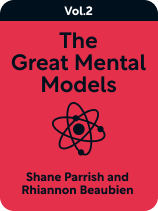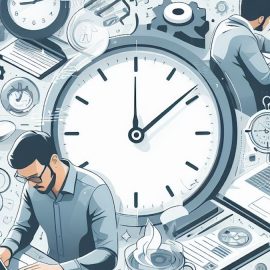

This article is an excerpt from the Shortform book guide to "The Great Mental Models Volume 2" by Shane Parrish and Rhiannon Beaubien. Shortform has the world's best summaries and analyses of books you should be reading.
Like this article? Sign up for a free trial here.
Why is eyewitness testimony so unreliable? Is it possible to use leverage to get what you want—without taking unfair advantage of others?
In The Great Mental Models Volume 2, Rhiannon Beaubien and Shane Parrish draw on models from science to help you figure out yourself and the world around you. They show how the theory of relativity can help you understand somebody you disagree with, and they explain how you can use leverage to get what you want in life.
Keep reading to learn the importance of understanding others in a way that benefits everyone.
Understanding Others
When working with others, it helps to understand their perspective so that we can learn from each other, coordinate our efforts, and avoid disagreements. Two scientific models can help achieve these ends. First, the model of relativity points to the importance of understanding others, especially recognizing their points of view. Then once you know where the other party is coming from, the model of leverage suggests ways you can use the other party’s needs to get what you want.
Relativity
To work with other people effectively, you should keep in mind that everyone sees the world differently. That’s the basis of Beaubien and Parrish’s model of relativity—the idea that our understanding of a situation depends on our perspective. They explain that, in physics, Einstein’s theories of relativity established that there’s no fixed frame of reference when observing physical phenomena—our perception of movement, distance, and time itself are dependent on our own position and speed relative to the event we’re observing.
| An Alternative Example of Relative Perspective While Beaubien and Parrish are correct that Einstein’s theories imply that our observations are relative, the actual theory of relativity is hard to picture in everyday life. Another scientific concept that points out the importance of perspective, and is simpler to illustrate, is the Doppler effect. The Doppler effect describes the way sound, light, and other waves distort as their source moves toward or away from the observer. This means that, in effect, two different observers will see or hear the same event differently depending on their position and movement. For example, if you stand by the side of the road while a car drives past, you’ll notice that the car’s sound changes in pitch as it passes you—the pitch is higher as the car approaches and lower as it drives away. That’s because as the car approaches, its movement toward you makes the sound waves reach you faster (effectively increasing their frequency, which raises their pitch), and as it drives away, its increasing distance causes the sound waves to spread out (decreasing their frequency and lowering their pitch). The key idea is that the Doppler effect only happens when the wave source and the observer are moving relative to each other. If you were moving at the same speed as the car, and alongside it, you wouldn’t notice any difference in pitch, because the sound waves would travel to you without being distorted by relative movement. On the other hand, if you were driving in the opposing lane, the effect would be amplified (which is why oncoming traffic “zips” by when you’re driving on the highway). |
As a scientific principle, relativity is mostly concerned with extreme values—movement approaching the speed of light or masses great enough to significantly affect gravity. But, as Beaubien and Parrish point out, relativity reminds us that no one’s account of the world is objectively true—everything we know or think we know is colored by subjective factors such as bias, limited perspective, and faulty memory. The authors explain that this is why eyewitness testimony, for example, is so unreliable. No matter how carefully witnesses observe an event or recall and describe their observations, there’s always a layer of subjective inaccuracy built into human experience.
| Our Interpretations Are Noisy The subjectivity of our interpretations is even more complicated than it first appears. In Noise, Daniel Kahneman, Olivier Sibony, and Cass R. Sunstein point out that our interpretations are affected by our experiences, personalities, and even by seemingly random factors like the weather or the time of day. In other words, your opinions aren’t just relative to other people’s—they’re relative from one moment to the next. Furthermore, the authors argue that in social situations, our interpretations sway each other without our even noticing. For example, once one person shares an opinion, other people are more likely to support that opinion regardless of their own initial thoughts on the issue. This phenomenon is called an information cascade, and it implies that the more popular an action or opinion appears to be, the more likely you are to support it. In these cases, your interpretations aren’t solely your own—they’re relative to your social environment. |
Because subjectivity is unavoidable, Beaubien and Parrish argue that it’s important to accept and appreciate other people’s points of view. They suggest that the best way to get a more complete picture of the world is to combine as many viewpoints as possible. On a practical level, that means that if you disagree with someone, don’t assume the other person is wrong—try to figure out why he or she sees things that way. Doing so can expand your horizons, improve your relationship with the other person, and cause the other person to reciprocate by taking your perspective into account.
(Shortform note: Often, the best way to learn about someone’s perspective is by having a conversation—but that’s not always easy to do when you disagree. In Difficult Conversations, Douglas Stone, Bruce Patton, and Sheila Heen offer extensive advice for listening to another person in order to understand where they’re coming from. For example, they suggest asking genuine questions with the goal of learning, paraphrasing the other person’s viewpoint to check your comprehension, and acknowledging the other person’s feelings.)
Leverage
Whereas relativity helps us understand where other people are coming from, Beaubien and Parrish point out that, once you know what other people want and need, you can use the model of leverage to help you get what you want.
(Shortform note: Although Beaubien and Parrish introduce relativity and leverage as two separate concepts, they build on each other because, as we’ll see, recognizing when you have leverage and making the most of it depends on your ability to see a situation from another party’s perspective and assess how they might be thinking or feeling.)
In physics, leverage refers to the use of a lever, a simple machine consisting of a rod or plank rotating around a fixed point. Levers multiply the force you apply to them, allowing you to lift or move things you couldn’t lift on your own. For example, a child would probably have a hard time lifting another child of similar size into the air—but if the children are both seated on a teeter-totter (a type of lever), they can lift each other up with very little effort.
In a social situation, having leverage means having a way to get what you want without applying large amounts of force. Beaubien and Parrish explain that leverage results from having something that other people want or need. The more they need it—and the less you need from them—the more leverage you have. For example, if you’re the general manager of a baseball team and you’re looking to trade your left fielder, you’ll probably get a better return from a team that has a weak outfield and is struggling to make the playoffs than from a first-place team with a strong outfield.
In short, Beaubien and Parrish say, leverage isn’t about pushing other people around—it’s about understanding where they’re coming from and figuring out how to make your offer as attractive to them as possible. The authors argue that people often think of leverage as a way of manipulating or coercing others to do your bidding. They counter that leverage, at its most effective, is an extension of reciprocity. In other words, you’ll get the best returns in an exchange when you focus on what you can offer others—just as you’d do when alloying or cooperating.
Conversely, Beaubien and Parrish acknowledge that it’s possible to use leverage to exploit others—though they warn that doing so ultimately undermines your position by teaching others not to trust you. Therefore, they suggest that if you want to keep your leverage, you should not push it too far.
| The Darker Side of Leverage and Empathy Whereas Beaubien and Parrish advise combining leverage with empathy to gently push others toward your desired end, some negotiation experts take a different approach, arguing instead that you should use empathy to maximize your leverage without necessarily increasing your material offer to the other person. For example, according to former FBI hostage negotiator Chris Voss, a skilled negotiator can increase her leverage by meeting her counterpart’s emotional needs. In Never Split the Difference, Voss argues that successful negotiation depends on your ability to gain your counterpart’s trust, which you can do by making the other person feel safe and in control. To make the other person feel safe, Voss recommends the same active listening techniques you’d use if your goal was to understand the other person’s viewpoint—the main difference is that in this case, you’re doing things like repeating the other party’s words and validating their emotions not only to understand their position but also to show that you understand it in order to get what you want from them. Voss explains that if the other party feels heard, they’re more likely to trust you. Similarly, Voss recommends that you give the other party the illusion of control by asking open-ended questions that ultimately guide your counterpart to think about how to solve your problems. For example, if you’re selling business accounting software, you might ask a potential client, “How can I make your accounting tasks easier?” The question invites information that will help you shape your sales pitch (for example, by telling you which software features to highlight) while making the client feel like you’re on her side. If you use these techniques to meet the other party’s emotional needs, Voss says that you’ll learn more about their hidden wants, which often include irrational biases that you can exploit in order to gain even more leverage. For instance, if the software client reveals that she thinks her current software solution is unfairly priced, the salesperson can exploit her desire for fairness to make his product look more attractive. |

———End of Preview———
Like what you just read? Read the rest of the world's best book summary and analysis of Shane Parrish and Rhiannon Beaubien's "The Great Mental Models Volume 2" at Shortform.
Here's what you'll find in our full The Great Mental Models Volume 2 summary:
- How you can understand anything by learning a finite set of rules and patterns
- How physics can help you improve interpersonal interactions
- Why making a major life change is so difficult






